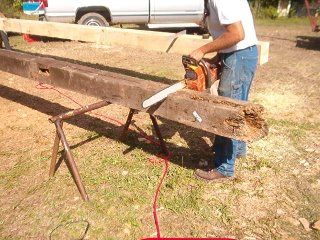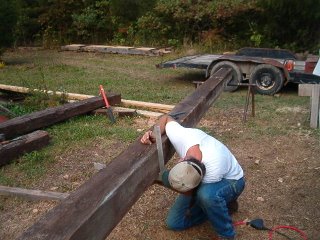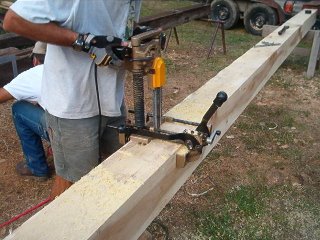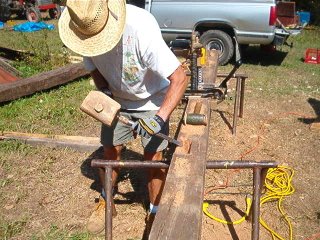After more than two years working to establish Raccoon Creek Community
with my fellow members, it has become clear to me that the community,
as we have envisioned it these past years, cannot become a reality on
the site in Owen County, Indiana, at least not within a reasonable
time frame, one much longer than I can accept, nor without further
compromises on waste treatment and perhaps other areas.
Over the next few weeks I will explain some of the reasoning used to
arrive at this difficult decision on a new blog.
We have put our hearts and souls into the project. Much work has been
done on and off the site, many meetings have been held there and
elsewhere, and much of the property was walked many times and marked
for various purposes. Walking away from the beautiful site at Raccoon
Creek is not easy.
The property will revert to Marion, our member who owned it to begin
with. Disposition of other assets, especially the large barn-to-be
will be decided over the next few weeks.
I hope Marion will still build on the site. It is currently zoned
"agricultural" which allows at least a single home to be built on it
with no further permissions needed.
I invite you to read about what we are doing now at
http://greeneviewsprings.blogspot.com. Your comments are welcome, but please send them to me at mailto:ed.paynter@gmail.com. This is my last post on this blog.
Thursday, August 16, 2007
Wednesday, May 09, 2007
The next step for us
While there has been no progress on the ground at the Raccoon Creek Community site since last fall, we have been moving along on the task of getting our waste treatment system(s) designed. More to come on that soon we hope.
In the mean time I've spent the winter working to get our home in Indianapolis ready to sell. We are planning to move as soon as it's sold, whether that's to temporary quarters on the Community site, or to a nearby alternative.
You can help. Tell everyone you know about our "House for Sale" ad which is now on line with 19 more photos. Here's the front with the yardful of yet-to-bloom perennials:
 6140 N College Ave, Indianapolis, IN
6140 N College Ave, Indianapolis, IN
In the mean time I've spent the winter working to get our home in Indianapolis ready to sell. We are planning to move as soon as it's sold, whether that's to temporary quarters on the Community site, or to a nearby alternative.
You can help. Tell everyone you know about our "House for Sale" ad which is now on line with 19 more photos. Here's the front with the yardful of yet-to-bloom perennials:
 6140 N College Ave, Indianapolis, IN
6140 N College Ave, Indianapolis, IN
Friday, February 02, 2007
It's finally winter in Indiana
We are finally "paying" for the mild fall and winter we've had so far. Temperatures over the next few days will likely fall below zero. We are more convinced than ever that we need to sell the home in Indianapolis and make it available for a larger family that can justify its size.
So what can one do while it's too cold outside to do any real work? How can one continue to promote a smaller footprint and a cleaner Earth? Here's what I've decided to do...

I have become an independent direct seller for a new program from a company called Citizenre. They will rent a complete photovoltaic solar electric system to any homeowner for a single up-front deposit. One's current electric rate will be locked in for the term of the rental, even if your local electric utility raises its rates. I'll reserve the rest of the details for those who are interested. Click on this sentence or the yellow "Rethink Solar" box to the right.
Even if you aren't interested in solar panels for yourself, please consider sharing this posting with friends and family who might be interested. Opportunities for other resellers are also available.
We now have a way to inexpensively provide solar power for Raccoon Creek Community homes without each household having to lay out tens of thousands of dollars for the equipment and to eliminate virtually all of our contribution to global climate change due to our power usage. Great!
By the way, the Citizenre unit will satisfy all of the power-related aspects of the LEED certification for homes soon to be released by U.S. Green Building Council. The LEED Rating System is the nationally recognized standard for green building.
So what can one do while it's too cold outside to do any real work? How can one continue to promote a smaller footprint and a cleaner Earth? Here's what I've decided to do...

I have become an independent direct seller for a new program from a company called Citizenre. They will rent a complete photovoltaic solar electric system to any homeowner for a single up-front deposit. One's current electric rate will be locked in for the term of the rental, even if your local electric utility raises its rates. I'll reserve the rest of the details for those who are interested. Click on this sentence or the yellow "Rethink Solar" box to the right.
Even if you aren't interested in solar panels for yourself, please consider sharing this posting with friends and family who might be interested. Opportunities for other resellers are also available.
We now have a way to inexpensively provide solar power for Raccoon Creek Community homes without each household having to lay out tens of thousands of dollars for the equipment and to eliminate virtually all of our contribution to global climate change due to our power usage. Great!
By the way, the Citizenre unit will satisfy all of the power-related aspects of the LEED certification for homes soon to be released by U.S. Green Building Council. The LEED Rating System is the nationally recognized standard for green building.
Wednesday, November 15, 2006
Postponement
Time and the weather have caught up with us and we have decided to postpone erection of the barn until spring.
Of fifty-eight main timbers and twelve top plates, only four, two 24-ft posts and two 23-ft beams, and the bulk of the top plates (8X8s, 20-24 feet long) remain to be completed. We will finish them this year, but the days are getting very short, the weather will soon be very cold, and about ten of them still need to be cut down in the future pond area, dragged out to the saw mill and "carved out" of the trees.
The foundation still must be dug and poured, and weather is an issue there, too. Also, if we put the timbers up yet this year we would need to install the rafters and roofing in the worst weather. The height of the barn combined with cold and maybe wet or snowy weather could make that a miserable (and perhaps dangerous) task this time of year. So the timbers will be protected under large billboard tarps through the winter.
We will take our time, finish the timbers, and lay out the foundation this year, and dig and pour it and erect the barn when it starts to warm up again. We can always use more time to work on plans for the interior, too.
On another topic, you should see the corduroy road that Sandy built almost single-handedly where the "road" had gotten very muddy at its clearing end. All sorts of wood scrap pieces from the milling operation were used, including some very bumpy left over log sections. It's raining again today, but I'll see her effort again tomorrow afternoon and report on how effective it is.
The tent I'd been using is put away for the winter and the pallet platform it was on is covered with a large tarp. Underneath has likely already been appropriated by some of our smaller wildlife friends. We'll let them have its use until springtime at least.
Of fifty-eight main timbers and twelve top plates, only four, two 24-ft posts and two 23-ft beams, and the bulk of the top plates (8X8s, 20-24 feet long) remain to be completed. We will finish them this year, but the days are getting very short, the weather will soon be very cold, and about ten of them still need to be cut down in the future pond area, dragged out to the saw mill and "carved out" of the trees.
The foundation still must be dug and poured, and weather is an issue there, too. Also, if we put the timbers up yet this year we would need to install the rafters and roofing in the worst weather. The height of the barn combined with cold and maybe wet or snowy weather could make that a miserable (and perhaps dangerous) task this time of year. So the timbers will be protected under large billboard tarps through the winter.
We will take our time, finish the timbers, and lay out the foundation this year, and dig and pour it and erect the barn when it starts to warm up again. We can always use more time to work on plans for the interior, too.
On another topic, you should see the corduroy road that Sandy built almost single-handedly where the "road" had gotten very muddy at its clearing end. All sorts of wood scrap pieces from the milling operation were used, including some very bumpy left over log sections. It's raining again today, but I'll see her effort again tomorrow afternoon and report on how effective it is.
The tent I'd been using is put away for the winter and the pallet platform it was on is covered with a large tarp. Underneath has likely already been appropriated by some of our smaller wildlife friends. We'll let them have its use until springtime at least.
Sunday, October 29, 2006
A Pattern Language
In 1977, Christopher Alexander and others wrote the book, "A Pattern Language" which, in a collection of over 250 interrelated "directives" called "patterns", describes and explains the reasoning behind each of the directives for creating communities, buildings, parks, roads, and building interiors in a way that satisfies human needs for community.
Each pattern entry includes a statement of a problem and a design solution, and is supported by examples and a discussion of how the authors arrived at the recommended solution or method.
For example, the pattern "High Places" states the "Problem" or need as:
and the "Solution" as:
Raccoon Creek Community has decided to apply as many of the patterns from "A Pattern Language" as might be appropriate in the design of our property and buildings.
As I was posting the entry about a possible silo for the barn I was reminded of our desire to incorporate appropriate patterns in our planning. Pattern 62 in called simply, "High places." Read about"A Pattern Language" if you'd like to understand some of the ideas that we will be incorporating at Raccoon Creek Community. Many other links to the book can be found on the Internet.
Each pattern entry includes a statement of a problem and a design solution, and is supported by examples and a discussion of how the authors arrived at the recommended solution or method.
For example, the pattern "High Places" states the "Problem" or need as:
"The instinct to climb up to some high place, from which you can look down and survey your world, seems to be a fundamental human instinct."
and the "Solution" as:
"Build occasional high places as landmarks throughout the city. They can be a natural part of the topography, or towers, or part of the roofs of the highest local building - but, in any case, they should include a physical climb."
Raccoon Creek Community has decided to apply as many of the patterns from "A Pattern Language" as might be appropriate in the design of our property and buildings.
As I was posting the entry about a possible silo for the barn I was reminded of our desire to incorporate appropriate patterns in our planning. Pattern 62 in called simply, "High places." Read about"A Pattern Language" if you'd like to understand some of the ideas that we will be incorporating at Raccoon Creek Community. Many other links to the book can be found on the Internet.
Should the barn have a silo?
That's the question we are considering.
Today, on the way home from the site, we visited a fellow who has converted his barn into his home and had a new silo added next to it. We learned of him from the fellow who built the silo. Here's a picture. Ours would be taller.
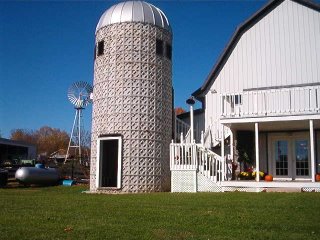
Since a stairway in the barn will use most of an entire bay, we have discussed using a silo instead to provide access to the barn's second floor. The silo would also provide a high observation point on the property from which we could see most or all of the homes depending on where it were placed.
We would build a staircase inside and have a door on both the ground and second floor levels with a railed walkway to the barn. Occasional windows along the stairs would allow natural light to enter. A platform would be built about 4 feet below the top of the silo and a smooth cap of some sort would be added to cover the tops of the silo panels. A removable cover would keep out any bad weather.
We will dicuss the possibility further. If we decide to build it maybe we can pour its foundation along with the barn foundation.
Today, on the way home from the site, we visited a fellow who has converted his barn into his home and had a new silo added next to it. We learned of him from the fellow who built the silo. Here's a picture. Ours would be taller.

Since a stairway in the barn will use most of an entire bay, we have discussed using a silo instead to provide access to the barn's second floor. The silo would also provide a high observation point on the property from which we could see most or all of the homes depending on where it were placed.
We would build a staircase inside and have a door on both the ground and second floor levels with a railed walkway to the barn. Occasional windows along the stairs would allow natural light to enter. A platform would be built about 4 feet below the top of the silo and a smooth cap of some sort would be added to cover the tops of the silo panels. A removable cover would keep out any bad weather.
We will dicuss the possibility further. If we decide to build it maybe we can pour its foundation along with the barn foundation.
October party
We had a great time last night just having fun at the Raccoon Creek Community site. Absolutely nothing practical was done! More than 20 friends visited, and some stayed until well past 10 PM.
The weather was nice all day and it wasn't too cold after dark. A nice fire and good conversation made a perfect end to the day.
Those who came before dark got a tour of the site, and almost everyone got a walkthrough of the process of turning a tree into a barn post, though a few of these were done by flashlight.
The milling operation continues this week.
In a very small tree on the edge of the clearing I found the small nest in the picture below. I have no idea what species built it. It looked as though it hadn't been used for a month or so.
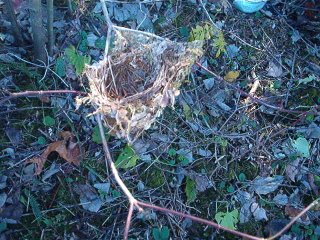
The weather was nice all day and it wasn't too cold after dark. A nice fire and good conversation made a perfect end to the day.
Those who came before dark got a tour of the site, and almost everyone got a walkthrough of the process of turning a tree into a barn post, though a few of these were done by flashlight.
The milling operation continues this week.
In a very small tree on the edge of the clearing I found the small nest in the picture below. I have no idea what species built it. It looked as though it hadn't been used for a month or so.

Tuesday, October 03, 2006
Two down, four to go
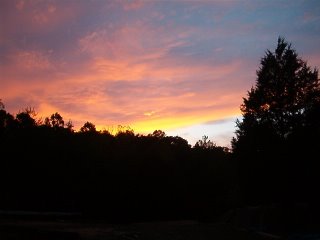
It's Monday evening and this picture doesn't do the sunset justice.
We completed the second of six bents today, and stacked them on the waiting pile. The outside posts and beams in the second and fifth bents are the easiest, meaning they have the fewest cuts to be made on them. The posts have just two housings for braces, and a single mortise for the beam. The beams have just two tenons. These two bents are a bit simpler than the rest. We are not putting knee braces on the beam so some of the outside bays will easier to use in tandem. On the outside bents that will have the knee braces, the bottoms of the braces will be at about 5 feet above the floor. We'll have to get used to their being there if they separate two bays that have no wall between them.
The outside bays will have mostly original timber posts from the old barn. Surprisingly, though they were on the outside walls of the old barn, more of them survived in a useable state than did interior posts. They are being cut shorter by about two feet which will make them lower than the main aisle. On the second floor this will mean taking two steps down from the main aisle to the outer bays.
I'm learning timber framing, one task at a time. The dirtiest job is watching as someone cuts through a large timber end with a chainsaw to tell him where he is with respect to the line on the bottom he cannot see. Sawdust falls right in one's face so a face mask and glasses are essential.
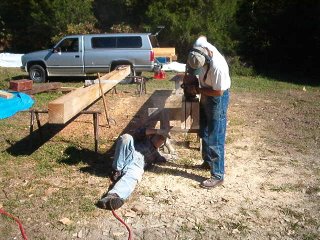
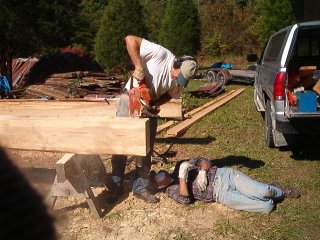
The hardest task is moving some of the larger timbers. Most times this is done with the tractor, but when there is only one or two to move, it sometimes isn't worth starting and manuevering the tractor, so we lift them by hand. Some wood species are a lot heavier than others.
It's likely to be a short week due to rain and a trip planned by one of the timber framers that starts Wednesday. That will give me a chance to get some more work done on the house so we can sell it. I hope to post more pictures of the timber manufacturing process also.
Thursday, September 28, 2006
Timber framing 101 -Mortises
What a month! - Work begins on the barn
Though there have been no posts to the blog in more than a month, it doesn't mean nothing has been happening.
We got bad news about the timbers we saved from the barn. Our timber framers, Red Tail Timberframes, LLC, evaluated all of them and found nearly two-thirds could not be used structurally in the new barn. Consequently we have to cut and mill many more timbers than we had planned. This has increased the cost of the barn, but there is an up side.
The original barn had four aisles, each 12 or 13 feet wide. Twelve-foot bays limit the uses of the barn. It also had extensions, about five feet long, at the top of twelve of the posts. This configuration would have made a third floor weaker and less useful.
Rather than cutting and manufacturing six more tall posts (24 feet each), our lead timber framer, Jason, proposed a new configuration for the barn to which we all quickly agreed.
The new barn will have only three aisles, but the main aisle will be 22 feet wide! This will allow us a single area that is 60 feet long and 22 feet wide, with a space of the same size possible on the second floor, and the third floor!, though the third floor will have lots less headroom.
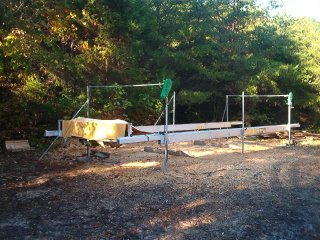 So far about half of the needed trees have been cut, all of them already fallen, standing dead, or severely compromised with few years left to be standing. All of them have been milled using a portable Lucas Mill saw mill that was built in Australia.
So far about half of the needed trees have been cut, all of them already fallen, standing dead, or severely compromised with few years left to be standing. All of them have been milled using a portable Lucas Mill saw mill that was built in Australia.
Along with the timbers which I learned must be from the center of the log, we now have many hundreds of board feet of dimension lumber, including many that are longer than the main aisle is wide, and enough scrap to last years for crafts, fire wood or camp fires.
We got bad news about the timbers we saved from the barn. Our timber framers, Red Tail Timberframes, LLC, evaluated all of them and found nearly two-thirds could not be used structurally in the new barn. Consequently we have to cut and mill many more timbers than we had planned. This has increased the cost of the barn, but there is an up side.
The original barn had four aisles, each 12 or 13 feet wide. Twelve-foot bays limit the uses of the barn. It also had extensions, about five feet long, at the top of twelve of the posts. This configuration would have made a third floor weaker and less useful.
Rather than cutting and manufacturing six more tall posts (24 feet each), our lead timber framer, Jason, proposed a new configuration for the barn to which we all quickly agreed.
The new barn will have only three aisles, but the main aisle will be 22 feet wide! This will allow us a single area that is 60 feet long and 22 feet wide, with a space of the same size possible on the second floor, and the third floor!, though the third floor will have lots less headroom.
 So far about half of the needed trees have been cut, all of them already fallen, standing dead, or severely compromised with few years left to be standing. All of them have been milled using a portable Lucas Mill saw mill that was built in Australia.
So far about half of the needed trees have been cut, all of them already fallen, standing dead, or severely compromised with few years left to be standing. All of them have been milled using a portable Lucas Mill saw mill that was built in Australia.Along with the timbers which I learned must be from the center of the log, we now have many hundreds of board feet of dimension lumber, including many that are longer than the main aisle is wide, and enough scrap to last years for crafts, fire wood or camp fires.
Monday, August 21, 2006
Sorting posts, building a platform, surveying
Once again it's been a long time between posts. That's because it's been a very busy summer so far.
I have been scraping and painting the last section of the eaves in the house in preparation for selling it. We held the last yard sale last weekend and got rid of a lot of stuff that we won't need in the future downsized house. We have rented a 10X20 storage room about 7 miles from Raccoon Creek and have moved about 2/3's of the home's contents to it or my daughter-in-law's garage. We still have bedroom, living room and dining room furniture in the house, but the dining room suite is for sale.
I have begun turning the front yard back into the standard, cookie cutter yard like every other one on the block by digging up all of the perennials in preparation for planting grass. Just the space between the sidewalk and the street has yielded about 60 large pots of plants. Many were sold at the yard sale, and more will be sold on the weekends we are at home, but most will go with us to Raccoon Creek. The rest of the front yard I estimate will yield about 200 more pots of perennials. I don't know how I'm going to deal with the hundred or so bulbs whose locations are only marked by their appearance in the spring.
Last week we finally put our most important agreements on how we will develop Raccoon Creek Community on one page. Most of the decisions had already been written in minutes of various meetings, but even we couldn't have found them all easily if we had to, so putting them on one page was a useful exercise. You can read them here.
Sunday we did the final survey for the property transfer. Approximately two acres have been added to place all of the planned east side pond within the community's boundaries. We were concerned that a future transfer of adjacent property to a land trust might cause some of the pond to become off limits to Raccoon Creek Community members due to "liability issues."
Today we began to sort through the barn parts that have been stored on the site since last fall. The plan is to lay out each bent (five posts, two post extensions and about 10 beams each) and decide which members have to be replaced. As each bent is inventoried it will be restacked as a set. When all six bents are catalogued, the process of making replacement parts will begin. We will then have to get really busy to get the 30 foundation piers built and the foundation walls between them before the new timber frame members are made aqnd the barn erection can go ahead.
If you are interested in the timber framing process, these next few weeks would be a great time to visit the site. We hope to use some trees from the pond site as replacement material for the old posts and beams we cannot use. These will be pulled from the woods using draft horses. Dates for that work will be set soon.
Finally today, using 15 discarded wooden pallets and eight @4X8 sheets of salvaged particle board, a platform was constructed to make tenting on the site for the next few months much more attractive. We will be able to leave a tent up without worrying about water seeping in when it rains, and without the usual lumps under our bedding. There is plenty of room for other tents from time to time.
If you'd like to come by to visit the site while we're there, send a note to the address in the column to the left of this entry.
I have been scraping and painting the last section of the eaves in the house in preparation for selling it. We held the last yard sale last weekend and got rid of a lot of stuff that we won't need in the future downsized house. We have rented a 10X20 storage room about 7 miles from Raccoon Creek and have moved about 2/3's of the home's contents to it or my daughter-in-law's garage. We still have bedroom, living room and dining room furniture in the house, but the dining room suite is for sale.
I have begun turning the front yard back into the standard, cookie cutter yard like every other one on the block by digging up all of the perennials in preparation for planting grass. Just the space between the sidewalk and the street has yielded about 60 large pots of plants. Many were sold at the yard sale, and more will be sold on the weekends we are at home, but most will go with us to Raccoon Creek. The rest of the front yard I estimate will yield about 200 more pots of perennials. I don't know how I'm going to deal with the hundred or so bulbs whose locations are only marked by their appearance in the spring.
Last week we finally put our most important agreements on how we will develop Raccoon Creek Community on one page. Most of the decisions had already been written in minutes of various meetings, but even we couldn't have found them all easily if we had to, so putting them on one page was a useful exercise. You can read them here.
Sunday we did the final survey for the property transfer. Approximately two acres have been added to place all of the planned east side pond within the community's boundaries. We were concerned that a future transfer of adjacent property to a land trust might cause some of the pond to become off limits to Raccoon Creek Community members due to "liability issues."
Today we began to sort through the barn parts that have been stored on the site since last fall. The plan is to lay out each bent (five posts, two post extensions and about 10 beams each) and decide which members have to be replaced. As each bent is inventoried it will be restacked as a set. When all six bents are catalogued, the process of making replacement parts will begin. We will then have to get really busy to get the 30 foundation piers built and the foundation walls between them before the new timber frame members are made aqnd the barn erection can go ahead.
If you are interested in the timber framing process, these next few weeks would be a great time to visit the site. We hope to use some trees from the pond site as replacement material for the old posts and beams we cannot use. These will be pulled from the woods using draft horses. Dates for that work will be set soon.
Finally today, using 15 discarded wooden pallets and eight @4X8 sheets of salvaged particle board, a platform was constructed to make tenting on the site for the next few months much more attractive. We will be able to leave a tent up without worrying about water seeping in when it rains, and without the usual lumps under our bedding. There is plenty of room for other tents from time to time.
If you'd like to come by to visit the site while we're there, send a note to the address in the column to the left of this entry.
Thursday, July 20, 2006
Engineer needed
We are working on the final plan for the layout of the barn. We are in a hurry to get the frame and roof up before cold weather. We do not want a second winter to go by with the frame stored near the ground.
Owen County officials have said they will approve the plan for just the frame and roof so we can concentrate on preserving the barn. Later, after it is up and safe, we will design and get their sign-off for the exterior and interior details. But before we can get the construction started we need to have an engineer to help design the foundation and sign off on it.
If you know of someone who would be good for this job, please let us know.
Owen County officials have said they will approve the plan for just the frame and roof so we can concentrate on preserving the barn. Later, after it is up and safe, we will design and get their sign-off for the exterior and interior details. But before we can get the construction started we need to have an engineer to help design the foundation and sign off on it.
If you know of someone who would be good for this job, please let us know.
Vacation's over: back to work
It's been a month and a half since the last posting. It doesn't seem that long since three weeks of it were spent in Europe. We had a great time and saw lots of things that will help at Raccoon Creek Community.
Since returning we have met with Red Tail Timber Frames owner and have agree to have them manage the reconstruction of our barn. They will begin in early August.
Missing posts and beams - parts that had rotted in the barn before we dismanteled it - will be replaced with timbers harvested from areas which will become ponds on the Raccoon Creek site. Red Tail will pull them from the woods using their draft horses, and mill them with their portable saw mill.
We have taken out a building permit for the barn, talked again with our REMC and gotten a quote from a well driller. Soon we will erect a tent or two and some screen tents so we can work at the site for a few days in a row without traveling back and forth so often.
If you've been wanting to visit the site, these next few weekends would be a great time. After that we should be very busy working on the barn.
Since returning we have met with Red Tail Timber Frames owner and have agree to have them manage the reconstruction of our barn. They will begin in early August.
Missing posts and beams - parts that had rotted in the barn before we dismanteled it - will be replaced with timbers harvested from areas which will become ponds on the Raccoon Creek site. Red Tail will pull them from the woods using their draft horses, and mill them with their portable saw mill.
We have taken out a building permit for the barn, talked again with our REMC and gotten a quote from a well driller. Soon we will erect a tent or two and some screen tents so we can work at the site for a few days in a row without traveling back and forth so often.
If you've been wanting to visit the site, these next few weekends would be a great time. After that we should be very busy working on the barn.
Thursday, June 01, 2006
Where have we been?
It's been about 3 weeks since the last posting. I've been occupied helping an elderly family member who has been in and out of the hospital and rehabilitation centers for the last 10 weeks or so. Except for the permaculture class week, it's been nearly an every-day visit to one facility or another.
Things have settled down and steady improvement is evidenced so we feel we can "safely" follow through with a long-planned, three-week trip to Europe that begins next week - on Wednesday the 7th. I hope to visit co-housing sites and see and learn about sustainable energy generation in Germany, The Netherlands and Sweden. If possible I'll post some entries showing what I've seen.
Until then I encourage you to visit the Rosneath Farm web site. Rosneath Farm is located in Australia, south of Perth, but their web site has much information that applies to any co-housing location.
They have obviously put lots of work into their effort. If you read something that you want to discuss with the Raccoon Creek Community, post a message to the RaccoonCreekForum. An easy fill-in for joining the Forum is located in the column on the left side of this page.
Things have settled down and steady improvement is evidenced so we feel we can "safely" follow through with a long-planned, three-week trip to Europe that begins next week - on Wednesday the 7th. I hope to visit co-housing sites and see and learn about sustainable energy generation in Germany, The Netherlands and Sweden. If possible I'll post some entries showing what I've seen.
Until then I encourage you to visit the Rosneath Farm web site. Rosneath Farm is located in Australia, south of Perth, but their web site has much information that applies to any co-housing location.
They have obviously put lots of work into their effort. If you read something that you want to discuss with the Raccoon Creek Community, post a message to the RaccoonCreekForum. An easy fill-in for joining the Forum is located in the column on the left side of this page.
Subscribe to:
Comments (Atom)

